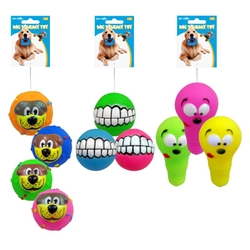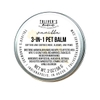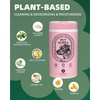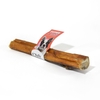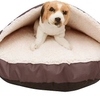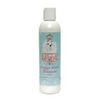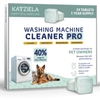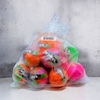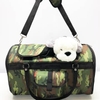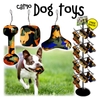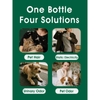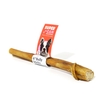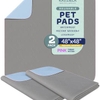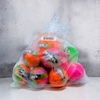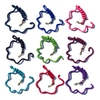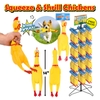
top vendors in pet supplies
best selling products
featured products
Recommended for you
Wholesale Pet Supplies
As of 2023, 66% of U.S. households (86.9 million homes) own a pet.
Owning a pet comes with a handful of responsibilities, such as providing food, taking care of their health and hygiene, and offering toys for play.
These responsibilities have increased market demand for pet supplies, and consequently, pet owners' expenditures.
The growth of the pet supply market is being driven by these increased demands, with projections indicating it will generate a striking $24.56 billion by 2028.
This presents a lucrative opportunity for both existing and new businesses to generate higher profits.
Segmentation of Products in the Pet Supply Market
The pet supply market offers a wide range of products that can be segmented by:
(i) Category:
- Pet Food: Includes dry pet food, treats, chews, etc.
- Pet Supplies: Includes grooming supplies, litter, litter boxes, clean-up and odor control products.
- Pet Health & Wellness Supplies: Includes vitamins and supplements, oral care supplies, deworming medication, flea and tick medication, and other medications.
- Pet Apparel & Accessories: Includes clothing, collars, leashes, etc.
Pet food and treats have the largest share and are projected to generate $42,386.03 million in 2023.
Despite the dominance of food, other categories like pet supplies also show strong performance according to Google Trends data over the past five years.
(ii) By Pet Type:
- Dogs
- Cats
- Birds
- Hamsters
- Fish & Aquatics
- Others
The dog and cat segments are the top performers in the pet supply category.
The dog pet supply segment is expected to hold the largest market share, as dogs are the most popular pets in the U.S. (65.1 million U.S. households own a dog), followed by cats (46.5 million households).
Best Products to Invest In For Better Performance
According to Google Trends data from the past five years, high-performing pet products include:
- GPS Pet Trackers
- Pet Cameras
- Smart Pet Feeders
- Automatic Litter Boxes
- Pet Grooming Kits
- Pet Carriers
- Collars and Leashes
- Pet Supplements
- Chew Toys
- Cat Scratchers
- Dog Beds
- Dog Training Pads
- Pet Stain Removers
These products have a steady demand, making them ideal for inclusion in business offerings to maximize sales.
Online Buying On the Rise for Pet Supplies
People buy pet supplies online for convenience, the ability to compare prices, and to find discounts and promotions.
Most online purchases include food, treats, and medications.
Business owners should consider establishing an online presence through a B2C online marketplace (for retailers) or a B2B online marketplace (for wholesalers) to attract online sales alongside offline sales.
Trends in the Pet Supply Industry
The pet industry is experiencing some noteworthy trends that you should be aware of to understand exactly what buyers are looking for.
These trends include:
- The rise of pet supplements, such as CBD oil, which are seen as a way to improve pet health.
- The preference of pet owners for natural pet food brands.
- The increasing number of pet food niches, such as freeze-dried and raw dog food.
- The popularity of luxury pet products, such as self-cleaning litter boxes and frozen yogurt for dogs.
- The emergence of new product categories, such as pet wipes and toothpaste.
These trends highlight the growing affection and care pet owners have for their furry friends, fueling the expansion of the pet supply industry.
Businesses should consider including these trending products in their catalog to stay current and enhance sales.
Advice for Efficient Inventory Management
Efficient inventory management is crucial for running a successful business. Here are some strategies to manage inventory effectively:
- Use Pet Inventory Management Software: Options include Petinode, Pet Store Retail Software, Katana, and Pet Store Software.
- Implement a Tracking System: Use barcodes or QR codes for all products.
- Rotate Inventory Regularly: Check for expired or nearly expired products.
- Monitor Sales Data: Identify which products are selling well and which are not.
- Dispose of Outdated or Damaged Products: This helps avoid fines or penalties for selling substandard products.
- Train Employees: Ensure all team members understand inventory management procedures.
- Back Up Inventory Data: Regularly backup data to prevent loss.
Legal and Regulatory Guidelines
The Food and Drug Administration (FDA) provides regulatory guidelines that must be followed by businesses in the pet supply niche:
- FDA-Approved Pet Food Ingredients: While pet food products do not require premarket approval, they must be safe for animal consumption, be manufactured under strict quality control standards, and contain FDA-approved ingredients. Ingredients recognized as Generally Recognized As Safe (GRAS) may not require FDA pre-approval.
- Substances Requiring FDA Approval: Minerals, vitamins, nutrients, flavoring additives, and coloring additives must obtain FDA pre-approval as per Title 21 Code of Federal Regulation.
- Proper Product Labeling: All pet food products must be truthfully labeled. The U.S. Association of American Feed Control Officials (AAFCO) has developed a set of “Model Regulations for Pet Food and Specialty Pet Food” contained in AAFCO’s Official Publication to promote uniform labeling standards.
By adhering to these guidelines and embracing efficient business practices, businesses in the pet supply market can achieve growth and maintain compliance with regulatory standards.
Back to top
Copyright 2025 Seebiz Inc. All rights reserved



